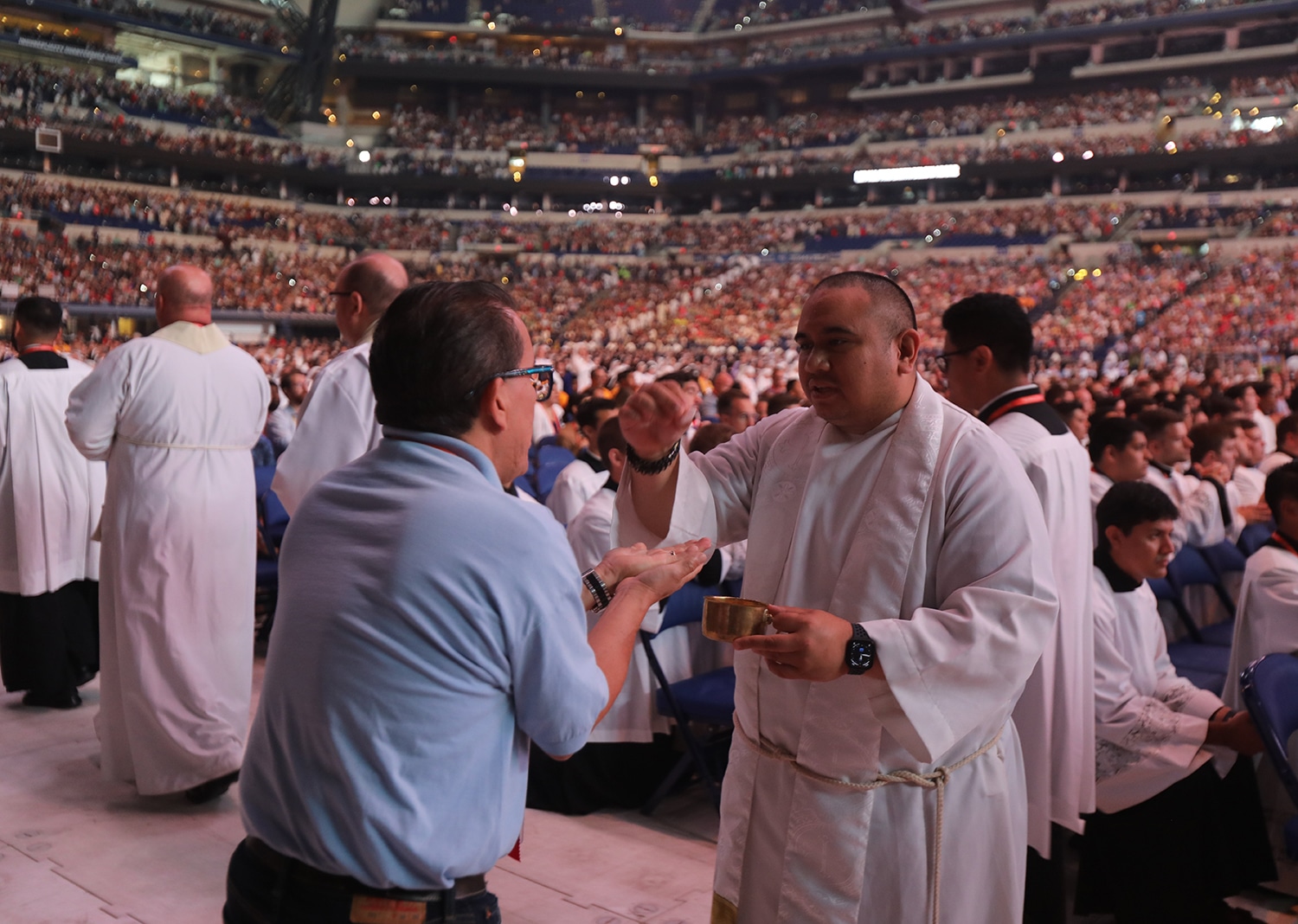INDIANAPOLIS (OSV News) — At Lucas Oil Stadium, Day 4 of the National Eucharistic Congress, began with a liturgy — and a story — from the church that St. Thomas the Apostle planted in India.
Tens of thousands of Catholics filled the stadium July 20 to celebrate together a Holy Qurbana, the Eucharistic liturgy of the Syro-Malabar Church, one of the Catholic Church’s 23 Eastern-rite churches, celebrated by Bishop Joy Alappatt of the St. Thomas Syro-Malabar Catholic Eparchy of Chicago. The bishop explained that the Qurbana, which he celebrated in English with some hymns in the original Syriac language “originated from the time of St. Thomas the Apostle … who came to India in A.D. 52, and because of his mission work we got a Catholic community in India.”
Ukrainian Catholic Archbishop Borys A. Gudziak of Philadelphia, who concelebrated the Holy Qurbana, told the thousands gathered that just as St. Thomas went forth to bring the Gospel to India, they too are called to share the Good News far and wide. He said, “Just think — 20,000 years from now, somebody might say … if we receive the (Holy Spirit), ‘Around the year 2,000, things really started going (for the church). People strengthened by the body and blood of the Lord, receiving the Holy Spirit, went out with the Good News.'”

Congress-goers joined in what organizers said may be the largest Eastern-rite liturgical celebration in the history of North America on a day dedicated to the theme “This Is My Body.”
Unity amid diversity
Bishop Andrew H. Cozzens of Crookston, Minnesota, told reporters later that morning that they wanted participants to experience the congress’s theme of unity amid the church’s “beautiful diversity.”
“The Catholic Church is a universal church. It speaks every language on earth. We’re the most diverse organization in the whole world, because every culture and every language celebrates the Eucharist differently,” he said.

For most attendees who were familiar with the Mass — the Latin Church’s form of Eucharistic liturgy — this was their first experience of the Holy Qurbana and gave them a deeper appreciation for Jesus’ gift of himself in the Eucharist.
“I felt like it just had everything that we believe, the Bible and Scripture all sort of wrapped from one end to the other,” Theodore Kuczek, an attorney from a northern suburb of Chicago, who said praying the different form of Eucharistic liturgy both felt familiar and emotionally stirring. “It was just very, very moving. The closing prayer … had us meditate on how joyful this was and to enjoy it now, because who knows if we’ll have it again.”
Youth Mass and inspirational message
During the morning’s youth Mass, Indianapolis Archbishop Charles C. Thompson spoke candidly to the young people about the impact that each one can make, even to the suffering.
“We don’t know the wounds people carry. We see some on the outside. The deepest wounds often are on the inside. We don’t know the lives we’re touching,” he said.
“But every time you … offer a smile, open a door, sit with a sick friend, say hello to a stranger — we never know the difference we’re making,” he said. “You never know how God is using us.”

He told the young people the church needed them as committed disciples of Jesus, and that their witness was a source of inspiration.
“It’s so important for us to keep in mind that the young people in our church are not the future of the church. You’re the young church now, and we need your energy,” he said. “We need your gifts now.”
Encounter impact session
In the Encounter impact session, theologian Edward Sri unpacked the scriptural context of a few parts of the Mass. He acknowledged that many Catholics might feel like “robots,” going through the motions of Mass without understanding what they say or why. Drawing on the wedding at Cana and scenes in Revelation, he explained that Mass is a wedding feast, and “every time you go to Mass, you’re getting a wedding invitation.”
Sri encouraged attendees to keep the “fire” they’ve experienced at the congress through community with other committed Catholics and being attentive to their relationship with people in their lives, especially their families.
Deacon Harold Burke-Sivers, an international speaker and author who spoke immediately after Sri, urged attendees to not shy away from their call to evangelize those around them by focusing on Jesus’ love.
“We have to remember, people may meet Jesus for the very first time when they meet you,” he said. “Filled with word and sacrament, you become his witness in the world, and that’s their first encounter with Jesus.”
Latino Catholic participation
Following the Mass in Spanish with Los Angeles Archbishop José H. Gomez, close to 2,000 Latino Catholics participated in the last Encuentro session of the congress.
Auxiliary Bishop Joseph A. Espaillat of New York discussed how to become missionary disciples through accompanying, listening, teaching and sending. He exhorted the audience to cheer for the risen Christ and not let this moment pass them by. “We are here to light a fire, Amen?” he said. “So, we don’t return to our homes being the same.”
Theologian Dora Tobar Mensbrugghe gave a presentation about the life of the disciple of Jesus and how a Eucharistic disciple is also a missionary.
“To be a disciple is not to be ‘knowers’ or ‘repeaters’ of his teachings, as beautiful as they are,” she said. “It is not about being mere admirers of the person of Christ.”
Rather, she said, Jesus wants his disciples to be transformed and “be creatures of love and for love. To be in his image.”
Family and community building
At the Cultivate impact session for families, Damon and Melanie Owens spoke about the importance of developing families’ communal relationships with each other. The couple of 31 years and parents of eight are the co-founders of the Joy Ever After marriage and family ministry.
“It’s essential to build a tribe, those families you can trust to share in forming your children, your family with,” said Damon. “Kids provide opportunities to meet families with other kids. But it’s about finding those who really share your faith, your values and mission, and making the decision to share with them.”
Melanie Owens encouraged moms to find a “collective of women to open up your heart with, where you can trust and support each other.”
She said, “I wanted Damon to fulfill me and make me happy, especially after I’d been with the kids all day. But I needed to form a collective with women to do that. That helps create better families.”
Loneliness and isolation
Lisa Brenninkmeyer, founder and CEO of Walking with Purpose, a Catholic ministry providing Bible studies and community for women, at the Empower session said that Catholics need to respond to the hidden epidemic that plagues the faithful and society as a whole: loneliness and isolation. She called attention to U.S. Surgeon General Dr. Vivek Murthy’s recent findings that “even before the onset of the COVID-19 pandemic, approximately half of U.S. adults reported experiencing measurable levels of loneliness.”
Drawing from the example of the early church in Acts, Brenninkmeyer said that “when the church comes together and offers an experience of true community, transformation happens.”
She acknowledged that St. Paul’s exhortation for Christians to “bear one another’s burdens” is not easy. “Isolation is frankly easier oftentimes,” she said.
“We come up against the pain of being in relationship with broken people and we get hurt,” she said, “so we pull back and we isolate,” but “the very circumstances that so often are indicating to us that we need to pull back from this community are the very things that God is bringing into our lives through the community so that we can be transformed into the image of Christ.”
She encouraged those gathered “to keep showing up,” building relationships within their community and growing them in their families in order to “build a church where no one stands alone.”
Leadership and evangelization
In the Renewal impact session for ministry leaders, Curtis Martin, founder of FOCUS, the missionary outreach to college students, told them they can only be effective evangelists if they trust the transformative power of the Gospel truly works. He exhorted them to have a sense of urgency and not become complacent. Martin said that while God will take care of things, “he really wants you to pray and to weep and to fast and to love the poor, because he did those things for us.”
“The crisis in our culture today is not because Jesus is less relevant. He has never been more relevant,” Martin said. “We have the best story in the world. Not only is it fascinating and compelling — it’s true.”
Supporting clergy and priests
At an emotional final Abide impact session for clergy, Dan Cellucci, CEO of the Catholic Leadership Institute, shared the story of his son Peter’s diagnosis with a malignant brain tumor at age 7 and how the illness was not “what he signed up for” as a husband and a father. He related the struggles of his fatherhood to the struggles that so many priests face in their own priestly ministries, where it is all too easy to become disillusioned and think that this is not “the cruise ship that I signed up for.”
“So many of you have been broken by trauma, by feeling betrayed … or just beat down,” he said.
He said to those “hanging on by a thread, ready to explode or implode because the life they said ‘yes’ to is now more than the life they imagined and wanted … you have made the right choice to be here, to be a part of this experience with your brothers, and I pray for you to hang on. Jesus wants to heal you.”
Bishop Daniel E. Flores of Brownsville, Texas, followed Cellucci’s testimony by contemplating with his brother priests the “poverty of Christ,” challenging them to become ever more configured to Christ and pouring themselves out for the good of their people.
“This is the point,” he said. “That the Christ makes himself fully present and fully known in his true sense of who God is — as the God who gives himself out.”
Anticipation of Eucharistic procession
As the morning’s sessions concluded, the Indiana Convention thrummed with joy and anticipation of the coming Eucharistic procession through downtown Indianapolis that afternoon. A massive line snaked through the convention center to see exhibits on Eucharistic miracles and the Shroud of Turin, while young people marched through singing joyfully their love for Jesus.

In another jubilant spontaneous moment, a group of women from all over the U.S. with the Catholic Women’s Association – Cameroon sang and danced to songs speaking their love for Jesus and Mary, expressed through their Cameroonian heritage.
“We’re thirsty for you Jesus, we’re thirsty for you, Jesus, we are thirsty for you — and that is why we are here.”
Contributing to this story were Julie Asher, Lauretta Brown, Gretchen R. Crowe, Maria-Pia Negro Chin, Gina Christian, Natalie Hoefer, John Shaughnessy, Peter Jesserer Smith and Maria Wiering.







